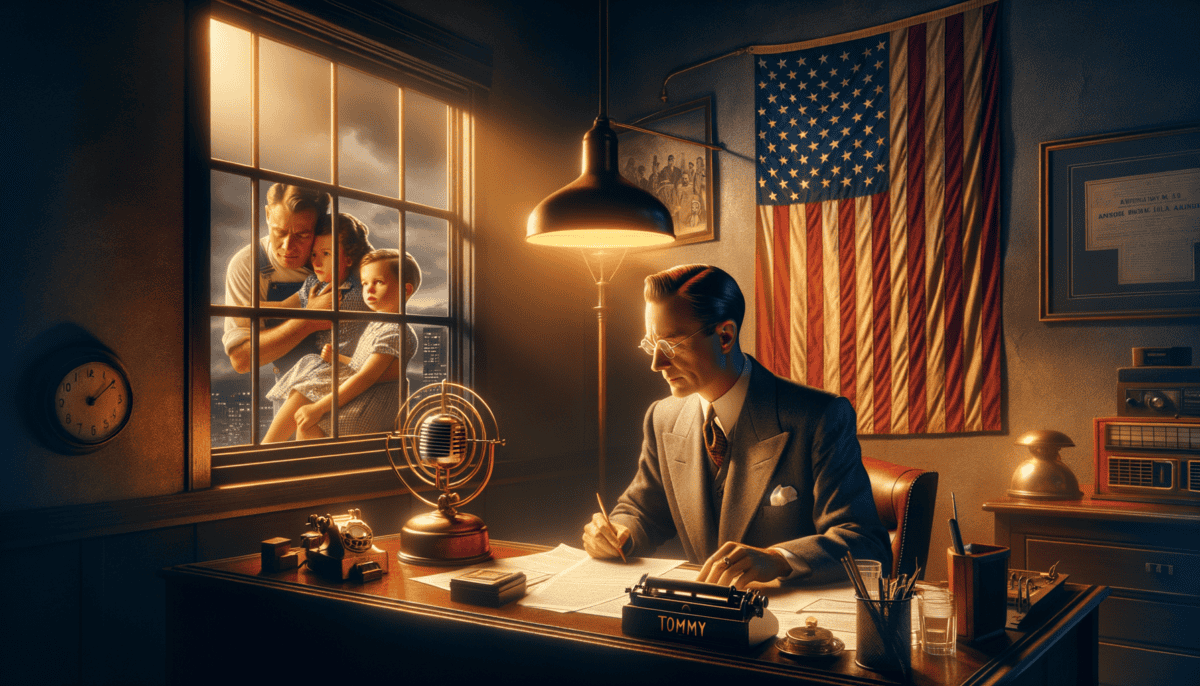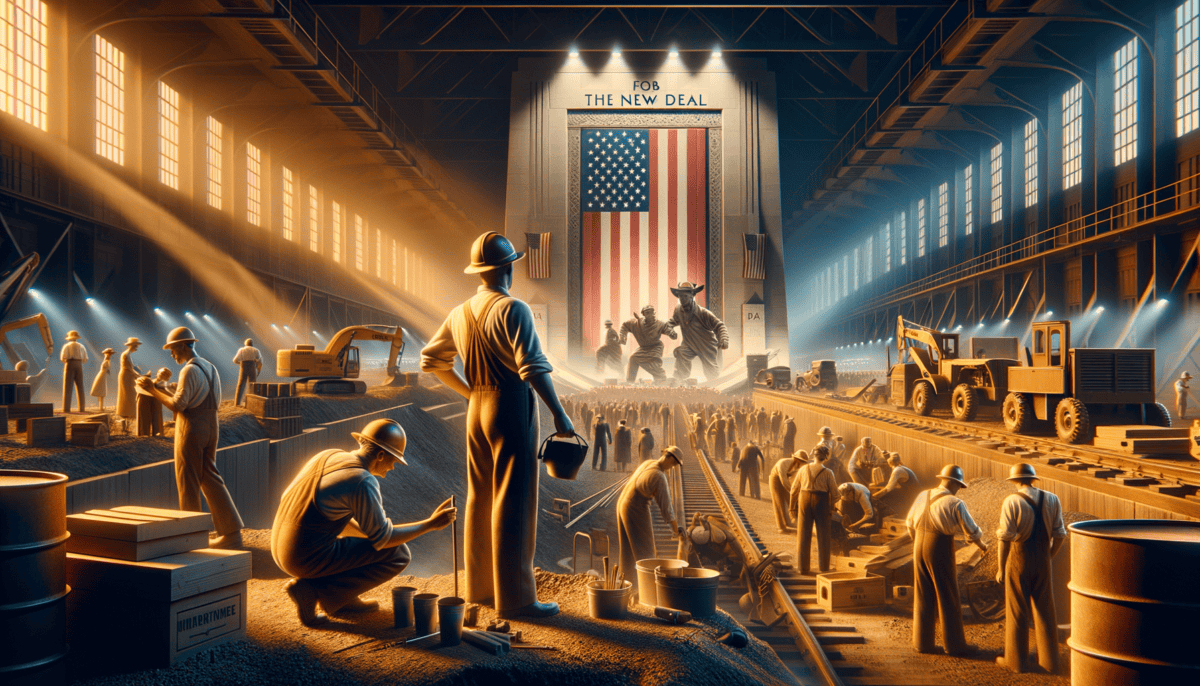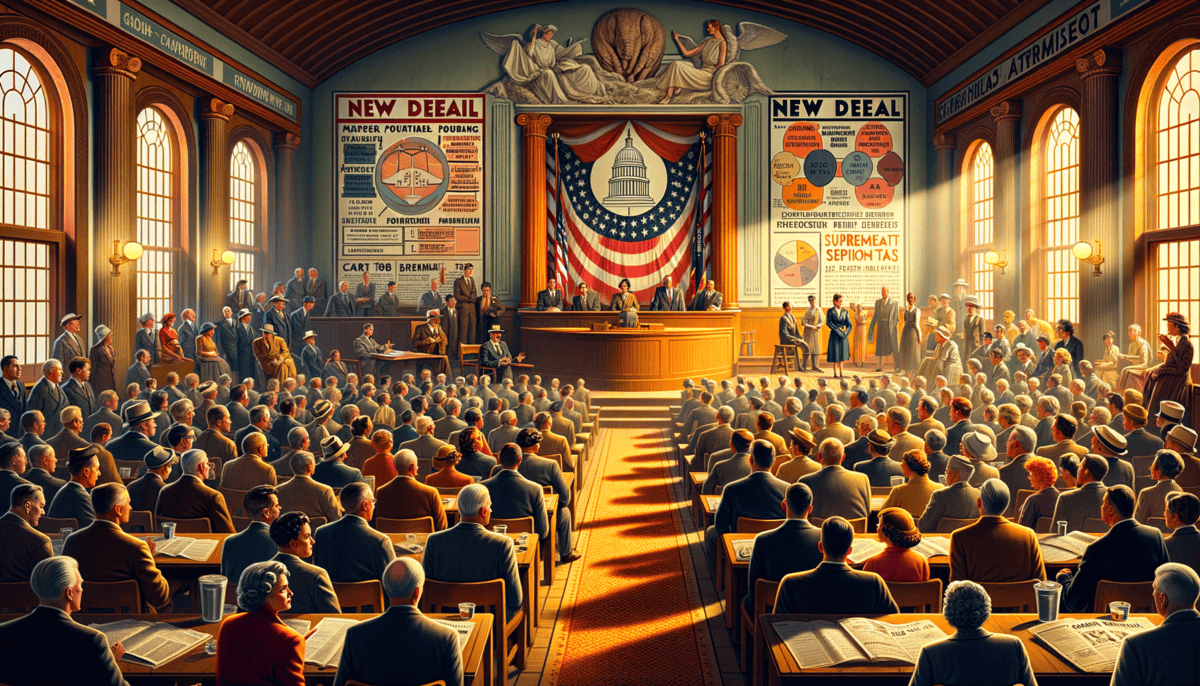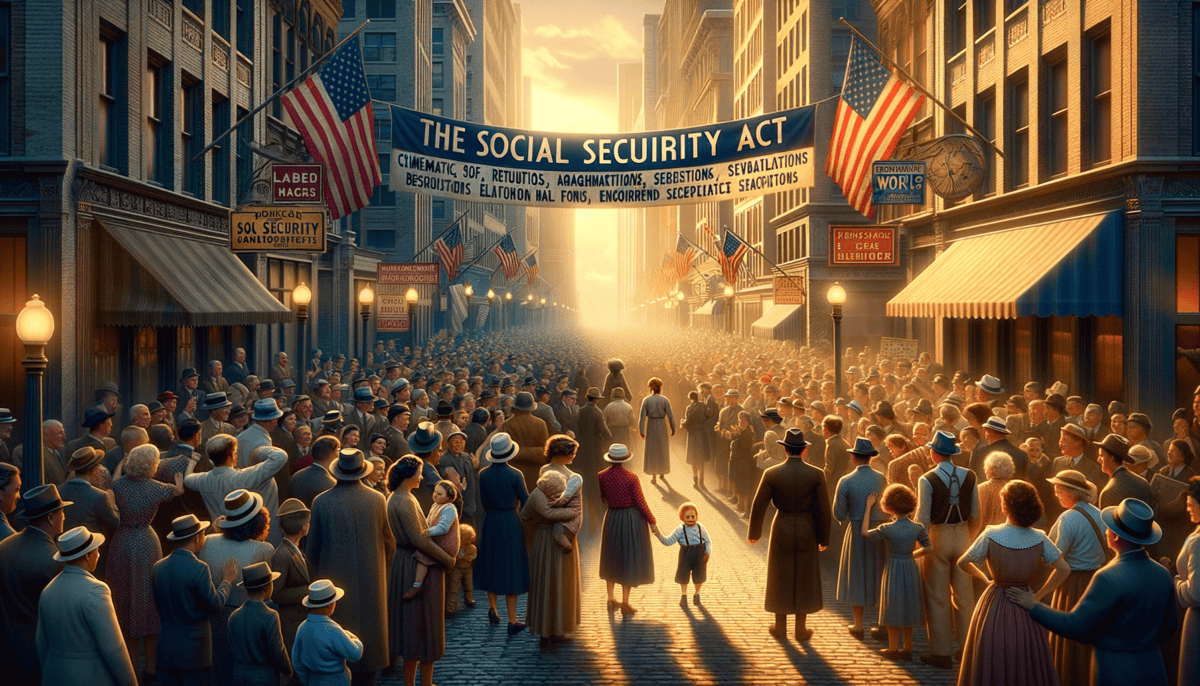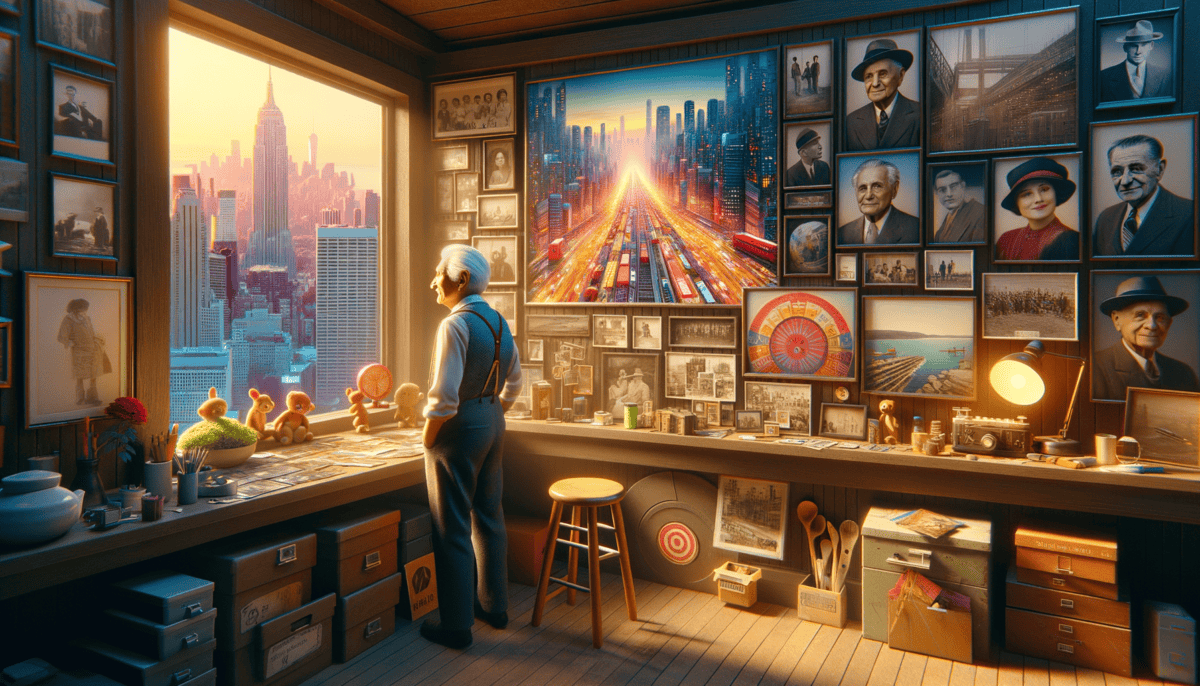Dark Days of Despair
Tommy pressed his nose against the cold window of his family's small apartment, watching people shuffle through the snowy Chicago streets below. It was 1932, and the world seemed very different from the happy stories his grandma used to tell him about the good old days.
"Mama, I'm hungry," Tommy whispered, turning to face his mother who was trying to make soup from just a few vegetables and water.
Mrs. Anderson smiled weakly. "I know, sweetheart. We'll eat soon." She stirred the thin broth, hoping it would somehow become more filling.
• 15 million Americans had no jobs
• Thousands of banks closed
• Many families lost their homes
• People waited in long lines for food
Tommy's father used to work at the bank downtown, but it closed like many others. Now he spent his days looking for any work he could find. Some days he came home with a few coins, other days with nothing at all.
"Look what I found!" Mr. Anderson burst through the door, holding up a newspaper. His face was red from the cold, but his eyes sparkled with hope. "The grocery store needs someone to sweep their floors. It's not much, but it's something!"
Tommy hugged his father's legs. Even at eight years old, he understood that any job was better than no job at all.
A City in Trouble
Outside their window, Chicago told the same sad story as cities across America. Closed shops had signs that read "Out of Business" in their windows. People wore old, patched clothes and carried empty shopping bags. Some folks even sold apples on street corners just to make a few pennies.
"Why did this happen, Papa?" Tommy asked one evening as they shared their small dinner.
Mr. Anderson sighed. "Well, son, it's like when you build a tower with your blocks. If you're not careful, one wrong move can make everything fall down. That's what happened to our country's money."
"But can't someone fix it?" Tommy asked. "Like how you fix my toys when they break?"
"People are trying, Tommy. We just have to be brave and help each other out."
Signs of Hope
Despite the hard times, Tommy's family found ways to stay positive. Mrs. Anderson taught the neighborhood children to read in their living room. Mr. Anderson helped fix things for neighbors who couldn't afford repairs. And Tommy? He became an expert at making people smile with his silly jokes.
"Why did the cookie go to the doctor?" he would ask anyone who looked sad. "Because it was feeling crumbly!"
Even in the darkest days, their apartment building became a tiny community where neighbors shared what little they had. Mrs. Rodriguez from upstairs sometimes brought over tortillas, while Mr. O'Brien from down the hall would share potatoes from his sister's farm.
“We might not have much,” Tommy’s mother often said, “but we have each other, and that’s worth more than all the money in those closed banks.”
One cold evening, as the family huddled around their small radio, they heard talk about a man named Franklin Roosevelt who promised to help fix things. Tommy didn't understand all the grown-up talk, but he could see the spark of hope in his parents' eyes.
"Maybe things will get better soon," his father said softly, pulling Tommy close.
As Tommy drifted off to sleep that night, he dreamed of better days ahead – days when his father would have a good job again, when his mother wouldn't have to make soup from almost nothing, and when the streets would be full of smiling people carrying full shopping bags.
Tomorrow would be another day of challenges, but the Andersons would face it together, just like millions of other American families during these dark days of the Great Depression.
A Voice of Hope
Tommy sat cross-legged on the floor next to the family’s radio, his eyes wide with wonder. It was March 4, 1933, and a new president was about to speak to America. The radio crackled with static as Franklin D. Roosevelt’s warm, friendly voice filled their small apartment.
“Listen carefully, Tommy,” Mr. Anderson whispered. “This is history happening right now.”
• “The only thing we have to fear is fear itself”
• He promised to help people get jobs
• He wanted to make banks safe again
• He gave people hope for better days
Mrs. Anderson wiped happy tears from her eyes. “He sounds so sure we can fix things,” she said, squeezing her husband’s hand.
A President Who Understood
“Did you know, Tommy,” his father said, “that President Roosevelt had a hard time too? He got very sick once and couldn’t walk easily. But he never gave up!”
Tommy thought about that. If someone who had trouble walking could become president, maybe anything was possible!
“Is he going to help Papa get a better job?” Tommy asked hopefully.
“He’s going to try, sweetheart,” his mother answered. “He has lots of ideas to help everyone.”
Changes Begin
The very next day, something big happened. The president closed all the banks for a few days. He called it a “bank holiday.”
“But Papa,” Tommy giggled, “banks don’t need vacations!”
Mr. Anderson smiled. “This holiday is to make the banks stronger and safer. Like when you rest when you’re sick to get better.”
“For the first time in months,” Mrs. Rodriguez said from next door, “I feel like someone is actually trying to help us regular folks.”
The Fireside Chat
A few days later, Roosevelt spoke on the radio again. He called it a “fireside chat,” like he was sitting right in their living room talking to them! Tommy loved how the president explained things in a way that even kids could understand.
“He talks just like a friendly neighbor,” Tommy said, scooting closer to the radio.
The president explained his plans to fix the country’s problems. He wanted to:
• Help farmers grow food
• Give people jobs building new things
• Make sure everyone had enough money to live
• Keep people’s money safe in banks
A New Beginning
That night at dinner, Tommy noticed his parents seemed different. His father sat up straighter, and his mother hummed while she cooked their simple meal.
“Things are going to get better,” Mr. Anderson said firmly. “President Roosevelt has a plan – he calls it the New Deal.”
“Like when we deal cards for Go Fish?” Tommy asked.
His parents laughed – a real, happy laugh that Tommy hadn’t heard in a long time. “Sort of,” his father said. “But this deal is about giving everyone a fair chance to work and earn money again.”
That evening, Tommy drew a picture of President Roosevelt. He drew him with a big smile and wrote “Thank You” at the top in his best handwriting.
“Can we send this to him, Mama?” Tommy asked.
“Of course we can, sweetheart,” she replied. “I think he’d love to know he’s giving hope to even the youngest Americans.”
As spring arrived in Chicago, the city seemed to wake up from its long, sad winter. People walked with their heads held higher, and sometimes Tommy even heard laughter in the streets. Change was coming to America, and everyone could feel it.
Building a Better Tomorrow
The sun was barely peeking over the horizon when Tommy heard excited voices outside. He rushed to the window of their Chicago apartment and saw men gathering on the street corner. His father was already dressed and putting on his cap.
“Where are you going, Papa?” Tommy asked, rubbing sleep from his eyes.
Mr. Anderson smiled – a real smile that reached his eyes. “I got a job, son! The government is starting new projects to build parks and roads. They’re calling it the Civilian Conservation Corps.”
• Building new parks
• Fixing old roads
• Planting trees
• Making new buildings
A Fresh Start
Mrs. Anderson hugged her husband tight. “It’s been so long since you’ve had steady work!”
Tommy watched as his father joined the other men outside. They walked with purpose, tools slung over their shoulders. The whole street seemed brighter somehow.
“Look at all those men going to work,” Tommy said proudly. “President Roosevelt really kept his promise!”
Changes in the Neighborhood
Over the next few weeks, Tommy saw amazing changes. The empty lot down the street became a beautiful park. Workers planted trees along the sidewalks. Even the old library got a fresh coat of paint!
“This isn’t just about building things,” Mr. Anderson explained at dinner. “We’re building hope. We’re building America’s future.”
Tommy’s family had more food on the table now. His mother didn’t worry so much about money. Best of all, his father whistled while he worked – something Tommy hadn’t heard in years.
Learning New Skills
One Saturday, Mr. Anderson took Tommy to see the new park he was helping build. The air smelled like fresh dirt and pine trees.
“Want to help plant a tree, son?” his father asked.
Tommy’s eyes lit up. “Can I really?”
Together, they dug a hole and carefully placed a small oak tree in the ground. “Someday,” his father said, “this tree will be taller than our building. And you can tell your own children you helped plant it.”
Community Spirit
The whole neighborhood felt different. Mrs. Rodriguez started a community garden in the new park. Mr. Chen from the grocery store donated seeds. Everyone worked together to make things better.
“It’s like one big family now,” Tommy told his mother as they watched people working in the garden.
“That’s right,” she smiled. “When we help each other, we all grow stronger.”
A Special Surprise
One evening, Mr. Anderson came home with exciting news. “The government is starting art classes for children at the new community center. Would you like to go, Tommy?”
Tommy couldn’t believe his ears. Real art classes! He’d always loved drawing but never had proper lessons before.
“This is part of the New Deal too,” his father explained. “President Roosevelt believes that art and culture are important for everyone, not just rich folks.”
At his first art class, Tommy met other kids from the neighborhood. Together, they painted a huge mural on the community center wall showing their hopes for the future: green parks, busy streets, and happy families.
Their art teacher, Miss Hayes, smiled at their work. “You children are painting more than just pictures,” she said. “You’re painting your dreams for tomorrow.”
Growing Hope
That night, as Tommy lay in bed, he thought about all the changes in his neighborhood. The empty lots were now parks. The broken roads were smooth and new. Best of all, people smiled more and helped each other.
“Papa,” he asked during breakfast the next morning, “is this what President Roosevelt meant by a New Deal?”
His father nodded proudly. “It sure is, son. We’re not just fixing things on the outside. We’re fixing America’s spirit too.”
Tommy looked out the window at his father’s tree, already growing straight and tall. Like that little oak, hope was taking root all across America, growing stronger every day.
Voices of Change
Tommy sat at the kitchen table, drawing in his sketchbook. The radio crackled with angry voices.
“Turn that noise off!” his mother called from the sink. But Tommy’s father shook his head.
“No, Mary. Tommy needs to understand. Not everyone likes the changes President Roosevelt is making.”
• Government spending too much money
• Changes happening too fast
• New rules for businesses
• Different ideas about helping people
Different Views
“But Papa, why don’t they like the new parks and jobs?” Tommy asked, confused. His tree in the park was growing taller every day.
“Some people think the government shouldn’t help so much,” Mr. Anderson explained. “Like Mr. Roberts at the bank. He says businesses should fix things on their own.”
The Big Debate
The next day at school, Tommy noticed something different. His best friend Billy wasn’t talking to him.
“What’s wrong?” Tommy asked during lunch.
Billy kicked at the ground. “My dad says your dad’s new job isn’t fair. He says the government is taking our money to pay for it.”
“Sometimes friends can disagree,” Tommy’s teacher Miss Wilson said later. “But we can still be kind to each other.”
A Visit to the Court
One afternoon, Tommy’s class took a trip to the courthouse. A judge was talking about President Roosevelt’s new laws.
“The Supreme Court has to decide if these changes follow our country’s rules,” the judge explained simply.
Tommy drew a picture of the big courthouse in his sketchbook. He added people on both sides, some smiling, some frowning.
Finding Middle Ground
At the community center, Tommy noticed something interesting. Mr. Roberts from the bank was talking with his father – and they were both smiling!
“Your father helped me see how the new programs are good for business too,” Mr. Roberts told Tommy. “When people have jobs, they can buy things from stores.”
“And Mr. Roberts showed me how we need to be careful with changes,” Tommy’s father added. “We’re learning from each other.”
A Community Picnic
The neighborhood decided to have a picnic in the new park. Everyone brought food to share. Tommy saw Billy there with his family.
“Want to climb the tree we planted?” Tommy asked. Billy smiled and nodded.
From up in the branches, they could see the whole park. People who disagreed about politics were sharing sandwiches and laughing together.
Learning to Listen
“You know what?” Billy said as they climbed down. “Maybe we can think different things and still be friends.”
That evening, Tommy added to his mural at the community center. He painted people with different colored shirts standing together, all helping to build a better town.
Miss Hayes smiled at his work. “That’s beautiful, Tommy. It shows how we’re stronger when we work together, even when we disagree.”
Moving Forward
At dinner, Tommy asked his father, “Is it okay that some people don’t like all the changes?”
“Yes, son,” Mr. Anderson replied. “In America, we can disagree and still respect each other. That’s what makes our country special.”
Tommy thought about the tree he and his father planted, now growing strong and tall. Like that tree, America was growing too – even when people disagreed about how to help it grow best.
A New Safety Net
Tommy watched his grandmother struggling to open a letter one morning. Her hands shook as she read.
“What’s that, Grandma?” Tommy asked, peering over her shoulder.
“It’s wonderful news, dear!” She smiled through happy tears. “The government is going to help old folks like me with something called Social Security!”
A Special Announcement
The whole family gathered around the radio that evening. President Roosevelt was explaining new ways to help Americans. Tommy’s father grabbed his notebook to write everything down.
“We’re making sure older Americans can live with dignity. No one should worry about having enough food or a place to live when they’re old.” – President Roosevelt
Changes at the Factory
Tommy visited his father at work one day. The factory looked different. There were new safety rails and better lights.
“The new laws protect workers,” Mr. Anderson explained proudly. “And we even get breaks now!”
• Safe working places
• Regular breaks
• Fair pay
• Shorter work days
Help for Everyone
At school, Tommy noticed his friend Sarah was happier. Her mom had found work in a dress shop.
“The boss has to follow new rules,” Sarah explained. “Mom gets paid the same as other workers now!”
A Special Savings Box
Tommy’s father showed him a new paper from work. “See these numbers? A little money from each paycheck goes into a special savings box. When I’m old like Grandma, I’ll get money back!”
Tommy grabbed his crayon box. “I’m going to make my own savings box too!”
Unions Make Changes
One Saturday, Tommy went with his father to a union meeting. Workers gathered to talk about their jobs.
“What’s a union, Papa?” Tommy whispered.
“It’s like a big family of workers,” his father explained. “We work together to make things better for everyone.”
A Community Celebration
The town held a parade to celebrate all the new changes. Tommy saw workers marching proudly with their union banners. His grandmother walked with other older folks, all smiling.
Miss Hayes, his art teacher, helped the children make a big banner: “A Better Life for All!”
Looking to the Future
That night, Tommy drew a picture of his whole family – mom, dad, Sarah, and Grandma. They all looked happy and safe.
“Things are getting better,” his mother said, hugging him. “And these new changes will help people for many years to come.”
Tommy pinned his drawing on the wall. Next to it, he wrote: “My Family is Safe.” He knew that now there were special ways to help everyone in America have a better life.
Sharing the Good News
At school the next day, Tommy told his friends about Social Security and worker protections. Even Billy, who used to disagree about the changes, thought these new ideas were good.
“My grandpa won’t have to worry so much now,” Billy said. “That makes me happy.”
Tommy added another branch to his tree drawing in the community center. This one had a nest, showing how the new laws helped protect and take care of people, just like a tree shelters birds in their nests.
A Legacy of Hope
Many years later, an older Tommy sat with his grandchildren in their cozy living room. The walls held black and white photos from the 1930s.
“Grandpa Tommy,” little Sarah asked, pointing to a faded picture, “tell us about the New Deal again!”
Memories of Change
Tommy smiled, remembering those important days. “Back then, America was like a broken toy that needed fixing. President Roosevelt and many brave people worked together to make things better.”
• Creating jobs for millions
• Protecting workers
• Helping older people
• Making banks safer
• Building roads and parks
Stories from the Heart
Tommy pulled out his old childhood diary. The pages were yellow and crispy now.
“Dear Diary, Today Dad got his first Social Security check. Grandma says it’s like a birthday present from America!” – Young Tommy’s entry
The Changes Live On
“Look around,” Tommy told his grandchildren. “See that bridge outside? Workers built that during the New Deal. The park where you play? That too!”
Little Jimmy’s eyes grew wide. “Really? All that old stuff is from then?”
“Yes, and more importantly, the helpful ideas live on. Your parents have Social Security cards, just like the first ones from my childhood!”
A Family’s Journey
Tommy showed them an old family photo. “See this factory? Your great-grandfather worked there. The New Deal made it safer for workers like him.”
“Is that why we have holidays and weekends?” asked Sarah.
“That’s right! And why workers get fair pay and safe places to work.” ♂️
Lessons for Today
Tommy’s daughter, a teacher, joined them. “The New Deal taught us something important,” she said. “When times are hard, Americans help each other.”
The children nodded, understanding how past changes made their lives better today.
The Spirit Lives On
Tommy walked with his grandchildren to the community center he’d visited as a boy. His childhood tree drawing was still there, faded but proud.
“Look,” he pointed, “we added new branches every time something good happened. The tree keeps growing, just like our country.”
The children touched the old drawing gently. “Can we add our own branch?” they asked.
“Of course! The story of helping each other never ends.”
A Future of Possibility
“Remember,” Tommy said, hugging his grandchildren, “the New Deal showed us that big problems can be fixed when people work together. That’s still true today.”
That evening, the children drew their own pictures of hope and help. They hung them next to Tommy’s old photos, connecting past to present, showing how good ideas grow stronger over time.
As stars twinkled outside, Tommy smiled. The spirit of the New Deal – of Americans helping Americans – lived on in these young hearts, ready to face whatever challenges tomorrow might bring. ⭐


